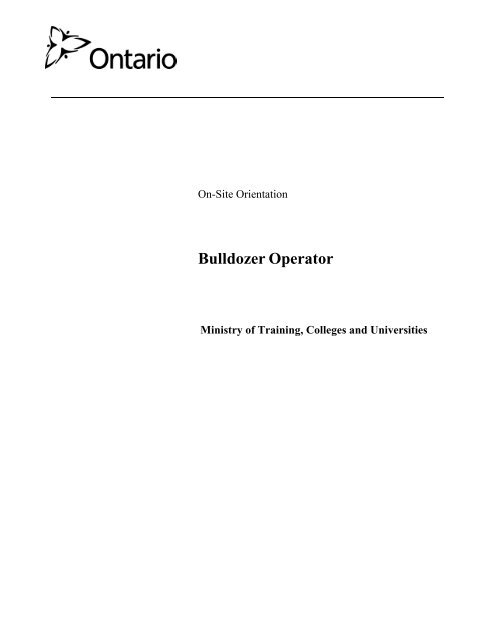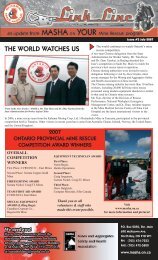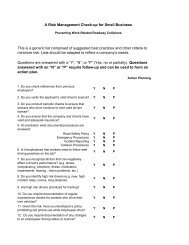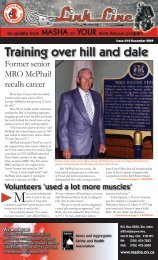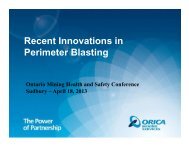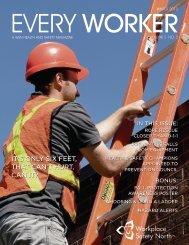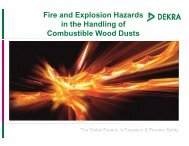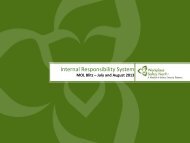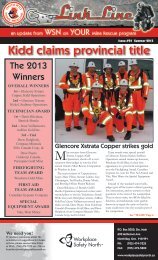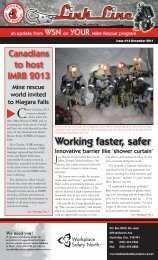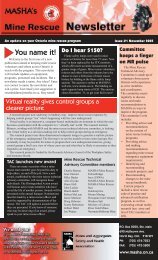Bulldozer Operator
Bulldozer On-Site Orientation - Workplace Safety North
Bulldozer On-Site Orientation - Workplace Safety North
- No tags were found...
Create successful ePaper yourself
Turn your PDF publications into a flip-book with our unique Google optimized e-Paper software.
On-Site Orientation<br />
<strong>Bulldozer</strong> <strong>Operator</strong><br />
Ministry of Training, Colleges and Universities
On-Site Orientation<br />
<strong>Bulldozer</strong> <strong>Operator</strong><br />
Program/Programme #P600103<br />
Development Date: August 2008<br />
Implementation Date: April 2009<br />
This document is the property of the trainee/employee named<br />
inside and represents the official record of his/her training.
BULLDOZER OPERATOR<br />
CONTENTS<br />
PAGE<br />
Preface............................................................................................................................................. 1<br />
Notice/Declaration for Collection of Personal Information............................................................ 2<br />
Completed On-Site Orientation: Worker and Employer/Designate Verification ........................... 3<br />
On-Site Orientation ....................................................................................................................3-19
BULLDOZER OPERATOR<br />
PREFACE<br />
The Workplace Training Branch of the Ministry of Training, Colleges and Universities (MTCU)<br />
developed this equipment-specific orientation document, in consultation with representatives from<br />
the logging industry. It is intended to be used by employers for on-site orientation of their<br />
workers/trainees before registration to the on-the job training or operating the machine related to<br />
their duties.<br />
The care and maintenance of this document is the joint responsibility of the worker/trainee and the<br />
employer. The document is an official record of a worker's/trainee's orientation.<br />
Employers or designates and workers/trainees are required to attest to successful on-site machine<br />
specific orientation by filling their names and signing on the appropriate lines.<br />
1
BULLDOZER OPERATOR<br />
NOTICE/DECLARATION FOR COLLECTION OF PERSONAL INFORMATION<br />
1. This information is collected under the authority of the Order-In-Council Number 701/85.<br />
2. The information is collected for the purpose of administering this modular training program<br />
within the Province of Ontario.<br />
3. Questions regarding collection and use of this information may be directed to:<br />
Director<br />
Ministry of Training, Colleges and Universities<br />
Service Delivery Branch<br />
33 Bloor St. E 2 nd Floor<br />
Toronto, Ontario<br />
M7A 2S3<br />
(416) 326-5605<br />
2
BULLDOZER OPERATOR<br />
BULLDOZER OPERATOR<br />
NOTE<br />
This guide and checklist is designed to refer employers and employees to the most obvious and<br />
critical component in each skill area. However, since machine model and make vary greatly, the<br />
primary reference material for specific machine safety related operating requirements should be the<br />
operator’s manual supplied by the manufacturer of the particular machine in question.<br />
Employer Information:<br />
Company: ________________________________________<br />
Address:<br />
________________________________________<br />
________________________________________<br />
Telephone: ________________________________________<br />
Completed On-site Orientation Checklist: Worker and Employer/Designate Verification<br />
□ Inspect workplace for hazardous and/or potential hazardous conditions<br />
□ Verify zero energy state<br />
□ Identify bulldozer components and terminology<br />
□ Conduct circle check<br />
□ Perform visual and operational checks of attachments and moving components<br />
□ for fluid leaks and damage<br />
□ Perform site planning and set up<br />
□ Travel with bulldozer<br />
□ Observe machine limitations<br />
□ Winch/Tow equipment<br />
□ Observe danger zone<br />
□ Shut down and immobilize bulldozer<br />
□ Refuel bulldozer<br />
□ Perform minor maintenance and adjustments<br />
Worker Name (Please Print): ______________________________________<br />
Worker Signature: _______________________________________________<br />
Date of Completion: ______________________________________________<br />
Employer/Designate (Please print): __________________________________<br />
Employer/Designate Signature: ______________________________________<br />
3
BULLDOZER OPERATOR<br />
INSPECT WORKPLACE FOR HAZARDOUS AND/OR POTENTIAL HAZARDOUS<br />
CONDITIONS<br />
Performance Objective<br />
Inspect workplace for hazardous and/or potentially hazardous conditions. Take corrective<br />
action by removing and/or addressing hazard according to legislative requirements,<br />
manufacturer specifications and recommendations.<br />
Guidelines for Performance Objective:<br />
1. Ensure that there is no unauthorized personnel in the work area. Access to the entire area must<br />
guarded and control.<br />
2. Review potential hazards such as under cut, overburden, angle of repose, and height of face.<br />
Height of working face of gravel pit or sand pit presents a risk to workers even if they are not<br />
working on top of it. Absolutely no undercutting of the working face is permitted. If the sand or<br />
gravel is being removed by powered equipment, the working face must be sloped at its angle of<br />
repose and the vertical height of the face must not be more than 1.5 metres above the maximum<br />
reach of the equipment. Identify and report hazards to supervision.<br />
Component Checklist:<br />
<br />
<br />
<br />
<br />
<br />
<br />
Unauthorized personnel and equipment<br />
Undercut<br />
Overburden<br />
Angle of repose<br />
Height of face<br />
Unstable ground<br />
4
BULLDOZER OPERATOR<br />
VERIFY ZERO ENERGY STATE<br />
Performance Objective<br />
Verify zero energy state, by ensuring machine is parked on level ground, lower hydraulic<br />
components to the ground or rest position, turn electrical switches and engine off, according to<br />
legislative requirements and manufacturer specifications and established lockout procedures, in<br />
order to protect self and others during inspection and maintenance.<br />
Guidelines for Performance Objective:<br />
1. The machine must be immobilized and all moving parts de-energized before an operator can<br />
begin to work close to the machine and its components. Most importantly all hydraulic<br />
implements must be lowered (or blocked). Follow lockout procedure.<br />
NOTE: Check with manufacturer supplied operator’s manual and immediate supervisor<br />
regarding correct procedures to apply the step-by-step lockout and verification procedure for<br />
your operation. Machines of different model or manufacturer may have different steps and<br />
requirements. The above is essential to ensure the safety of the operator and co-workers, as well<br />
as to confirm zero energy state prior to initiating the circle check procedures and other<br />
maintenance and trouble shooting functions. <strong>Operator</strong>s must have proper out-of-the-cab PPE<br />
e.g. -safety boots laced to the top, hard hat, high visibility vest or clothing, as well as hand,<br />
hearing, and eye protection where required.<br />
Component Checklist:<br />
<br />
<br />
<br />
<br />
<br />
Lower blade and other components to the rest position or to the manufacturer specifications.<br />
Engage transmission lock and/or parking braking system.<br />
Put engine in idle (cool down).<br />
Turn engine off.<br />
Follow lockout procedure.<br />
5
IDENTIFY BULLDOZER COMPONENTS AND TERMINOLOGY<br />
Performance Objective<br />
BULLDOZER OPERATOR<br />
Identify bulldozer components and terminology, visually and verbally, as described in the<br />
manufacturer manual, in order to ensure safe and efficient operation and maintenance.<br />
(Employer, supervisor or trainer refer to manufacturer manual to provide specifics regarding<br />
each component identified)<br />
Guidelines for Performance Objective:<br />
1. Having an understanding of the terminology used to describe major components is a vital part of<br />
using the manufacturer manual effectively and ensuring that such things as safety information,<br />
maintenance schedules, machine capacities and operating directions are understood and correctly<br />
applied. Reviewing the major (key) components from the machine manufacturer manual will<br />
assist the operator in identifying the key components, knowing their location on the machine and<br />
describing their purpose. (see appropriate pages in machine manufacturer manual for specific<br />
terminology and diagrams)<br />
Component Checklist:<br />
<br />
<br />
<br />
<br />
<br />
<br />
Hydraulic cylinders and attachments (winch, blade, ripper)<br />
Carriage and components (Tires and Tire Chains, Tracks)<br />
Cab and <strong>Operator</strong> Controls<br />
Engine<br />
Hydraulic pumps<br />
Fire Suppression Equipment<br />
6
BULLDOZER OPERATOR<br />
CONDUCT CIRCLE CHECK<br />
Performance Objective<br />
Perform visual and operational checks of attachments, ensuring that all attachments are lowered<br />
to the ground or in the rest position and the machine is properly shut down prior to initiating the<br />
circle check procedure. All substandard conditions and problems must be reported to the<br />
immediate supervisor. The circle check must be conducted at the beginning of each shift.<br />
NOTE: <strong>Operator</strong>s must have proper out-of-the-cab PPE e.g. - safety boots laced to the top, hard<br />
hat, high visibility vest or clothing, as well as hand, hearing and eye protection where required.<br />
Guidelines for Performance Objective:<br />
1. Cracks: Explain how to check and identify cracks and point out common locations where cracks<br />
may form (stress points). Point out that repairs must be done as soon as possible to prevent costly<br />
breakdowns and to prevent even further damage or the potential of injury to the operator and<br />
others.<br />
2. Leaks: Show the locations where leaks (hydraulic fluid, brake fluid, fuel) can occur. Explain that<br />
leaks can lead to further more serious problems, cause fires or damage the environment. Leaks can<br />
also cause slip and fall injuries to operator and others due to fluid on machine. Explain the danger<br />
of checking for leaks where fluid is under high pressure (e.g. hydraulic fluid) and the proper<br />
method for checking.<br />
3. Grease fittings: Identify the location (including remote connections), condition and purpose of<br />
grease fittings as described in the routine maintenance section of the owner’s manual. Check to<br />
ensure they are in good condition and connected properly. Excessive grease build-up should be<br />
cleaned regularly to prevent the potential of slips and falls and fire.<br />
4. Tracks, pads and pad bolts: Ensure adequate tension and proper adjustment of the tracks. Check<br />
for loose, worn, damaged or missing pads, bolts, grousers, idlers and main pins. Examine the<br />
condition of pins and bushings including the locking device on pins and watch for signs of wear or<br />
breakage of pins and bushings.<br />
5. Tires, wheels, and chains: Explain the requirements for correct pressure, adequate tread, no<br />
punctures or defects, rim in good condition, cap on valve stem. Follow the manufacturer<br />
guidelines when inflating/deflating tires. Ensure that chains are properly installed and tightened.<br />
If too loose, debris can be caught in chains and thrown out with considerable force. Watch for<br />
excessive wear, missing or damaged clevis pieces or loose parts of the chain. Also check for<br />
loose or missing wheel lugs.<br />
6. Engine/manifold area: Check engine compartment and exhaust manifold/turbo for debris. Check<br />
and remove debris from engine compartment to reduce the potential for fire, pay particular<br />
attention to the manifold/turbo/radiator areas.<br />
7
BULLDOZER OPERATOR<br />
7. Pins and Bushings: Examine holding pins and bushings for damage; ensure they’re engaged<br />
properly and in place.<br />
8. Check fluid levels: Identify location of site glass and/or dip stick/cap and filler locations and<br />
check for proper levels. Keep areas clean of debris, spilled fluids and grease build-up. Determine<br />
and confirm type of fluid at each filling location. Follow manufacturer guidelines for proper<br />
checking procedures of pressurized systems. No smoking during these procedures and know the<br />
hazards of hot fluids. When checking and identifying hydraulic hose requirements, the operator<br />
must be familiar with the types of hose fittings. (3 types - GIC, OFS and Pipe Thread)<br />
9. Blade and winch (if applicable): Check visually all pins and pivot points, cutting edge and<br />
moldboard. Before angling blade manually ensure that the king pin is not damaged. Examine<br />
the condition of the winch cable and drum, and winch hook for burrs or frayed cables, check<br />
rollers for free movement and wear. Wear double palm gloves when handling cable.<br />
10. Lift and tilt cylinders: Check for cracks, condition of pins (locks), and the condition of cylinders<br />
keeping an eye out for leaks, damaged grease fittings, hoses, and bolts.<br />
11. Condition of guards, catwalks, handholds and steps: Examine all guards to ensure that they are<br />
properly installed and in good condition. Do not operate without guards installed. Check the<br />
condition of all handholds, steps and walkways to ensure they are not damaged and free from<br />
debris, ice snow, grease and oil.<br />
12. Fire extinguisher and/or fire suppression system: <strong>Operator</strong>s must know how to access equipment<br />
and how to use it. Check daily to ensure a proper charge, maintenance tag is updated, the pin is in<br />
place and device is properly secured in cab. A full water pack in working condition is required for<br />
fire season. For machines equipped with a fire suppression system, know the location(s) of<br />
activation plungers and ensure they are in good condition. Check outlets for good condition.<br />
13. Escape hatch: The operator must know the location of the escape hatch and procedure to exit.<br />
Check to ensure that the hatch opens and, the latches, hinges, handle, and pins are in good<br />
condition, and the procedure to exit.<br />
14. Seat belt: Examine seat belt to ensure that it is in good working condition (wear, anchors, frayed,<br />
buckle works freely).<br />
15. Lights: Turn on all lights to check that they are in good working order. If guarded, make sure<br />
the guards are in place, the lenses are cleaned and wiring harnesses are intact.<br />
16. Windows/doors: Examine windows and doors to ensure they are clean and in good condition.<br />
Broken or missing windows must be reported and repaired. Check to see door opens and closes<br />
properly. Make sure wipers and wiper blades are in working order, and that window guards/<br />
screens (if equipped) are properly installed.<br />
8
BULLDOZER OPERATOR<br />
17. Housekeeping and loose equipment in cab: Keep all tools outside the cab or properly secured<br />
in the cab. No loose items in the cab. Keep floor clean and air conditioning/heater filters<br />
clear of materials. Aerosol containers should be secured and away from heat sources.<br />
18. Radio communications: Check the radio to ensure that it is in good working order and equipped<br />
for channels used in your area (if applicable).<br />
19. First-Aid Kit: Know the location, condition and required contents of the first aid kit. It should<br />
be easily accessible. Know trained first aid caregivers on-site.<br />
20. Spill Kit: Know the location, condition, how to use it, required contents of the spill kit. It<br />
should be easily accessible.<br />
21. Reflective/Flare kit: Know the location, condition, how to use the required contents. It should<br />
be easily accessible.<br />
22. Back-up Alarm: Check back-up alarm to ensure that it is in good working order and audible.<br />
Component Checklist:<br />
<br />
<br />
<br />
<br />
<br />
<br />
<br />
<br />
<br />
<br />
<br />
<br />
<br />
<br />
<br />
<br />
<br />
<br />
<br />
Check for cracks and leaks<br />
Identify grease fittings<br />
Check Tire/Track components condition<br />
Check engine compartment and manifold for debris<br />
Check Condition of pins and bushing<br />
Check fluid levels<br />
Check condition of blade<br />
Check condition of hydraulic cylinders<br />
Check condition of guards, handholds and steps<br />
Check condition of fire extinguisher and/or fire suppression system<br />
Check condition of escape hatch<br />
Check condition of seat belt<br />
Check lights<br />
Check condition of windows, wipers and guards<br />
Check housekeeping and remove, or properly stow loose equipment in cab<br />
Check radio communication (if applicable)<br />
Check first-aid kit<br />
Check spill kit<br />
Check back-up alarm<br />
9
BULLDOZER OPERATOR<br />
PERFORM VISUAL AND OPERATIONAL CHECKS OF ATTACHMENTS AND<br />
MOVING COMPONENTS FOR FLUID LEAKS AND DAMAGE<br />
Performance Objective<br />
Check attachments for proper operation, fluid leaks and damage, according to manufacturer<br />
specifications, in order to ensure safe and efficient operation of equipment<br />
Guidelines for Performance Objective:<br />
1. Activate parking brake and/or hydraulic/transmission interlocks: Check the danger zone to<br />
ensure it is free of co-workers or other equipment prior to activating the system. Check for<br />
proper operation of components. If defects are detected report immediately to your supervisor.<br />
2. Check attachments for damage: Make sure the attachments are not damaged and that no leaks<br />
are apparent.<br />
3. With the transmission locked or in neutral, all controls in the rest position, engine running,<br />
lights turned on and emergency braking applied, dismount from cab using 3-point contact,<br />
complete one more walk around the machine, checking for fluid leaks or other obvious damage.<br />
Component Checklist:<br />
<br />
<br />
<br />
Activate parking brake and/or hydraulic/transmission interlocks<br />
Check attachments for damage and leaks<br />
Visual inspection, when walking around machine, with engine running<br />
10
BULLDOZER OPERATOR<br />
PERFORM SITE PLANNING AND SET UP<br />
Performance Objective<br />
Plan and organize dozing pattern, using maps, photographs, and established road/pit boundaries,<br />
in order to facilitate material extraction and minimize ground disturbances. Evaluate and<br />
recognize ground conditions by observing changes in terrain and weather conditions, in order to<br />
prevent equipment and environmental damage and to protect self and others. Observe road/pit<br />
boundaries, according to pre-established prescriptions and legislative requirements in order to<br />
prevent entry into protected and non-allocated areas.<br />
Guidelines for Performance Objective:<br />
1. Identify dozing pattern: Check with your immediate supervisor to determine any environmental or<br />
other potential hazards in the immediate area utilizing maps, photographs and established road/pit<br />
boundaries to assist you. (i.e. chicots, hang-ups, terrain, traffic or other equipment, power lines).<br />
2. Identify travel route: Check with your immediate supervisor and/or cross-shift operator<br />
regarding hazardous terrain that must be taken into consideration (i.e. Rough terrain, wet areas).<br />
3. Minimize rutting and ground disturbances: Be aware of ground disturbance guidelines for your<br />
operation and if unsure check with your immediate supervisor. RUTS CAN POSE UNSAFE<br />
CONDITION FOR MACHINE OPERATION<br />
4. Maintain a safe operating distance between neighbouring equipment: Be aware of other<br />
equipment working in your work area. Check with your immediate supervisor and co-workers<br />
to identify appropriate danger zones for your operation. Follow the danger zone communication<br />
rules for your operation.<br />
5. Working on hills: When possible, working on inclines should be conducted in direction of slope<br />
to reduce potential of roll over. Working should be conducted straight up and down steep hills.<br />
Avoid travelling over high stumps, rocks and windfalls. Discuss ground condition concerns with<br />
your immediate supervisor or the previous shift co-worker at beginning of each shift.<br />
6. Seasonal concerns (winter, summer) requires extra caution to be exercised due to poor visibility<br />
and hidden hazards. Be aware of these hidden hazards due to seasonal conditions (i.e. ditches<br />
along roadways frozen/covered with snow, culverts hidden by snow, hidden areas of concerns<br />
such as recently planted areas, hidden rock outcrops/cliffs). Summer conditions pose a hazard of<br />
fire being ignited due to machine tracks on rocks. <strong>Operator</strong>s must be on the look out for ignition<br />
of underbrush.<br />
7. Operate equipment within identified boundaries: Check with your immediate supervisor in<br />
relation to boundary identification rules. (i.e. colour of ribbon used to identify concerns and<br />
boundaries). Observe established rules and if unsure confirm with your immediate supervisor.<br />
11
BULLDOZER OPERATOR<br />
Component Checklist:<br />
<br />
<br />
<br />
<br />
<br />
<br />
<br />
<br />
Identify dozing pattern<br />
Identify travel route<br />
Minimize rutting and ground disturbance<br />
Maintain a safe operating distance between neighbouring equipment<br />
Operate equipment within identified road/pit boundaries<br />
Working on hills should be conducted in direction of slope to reduce potential of roll over<br />
Minimize crossing of drainage areas to reduce rutting in wet areas<br />
Seasonal concerns (winter, summer) require extra caution due to poor visibility, hidden hazards<br />
and slippery surfaces<br />
12
BULLDOZER OPERATOR<br />
TRAVEL WITH BULLDOZER<br />
Performance Objective<br />
Prepare machine for travel by placing attachments in travel position. Adjust speed according to<br />
conditions of the environment and manufacturer specifications to protect self and others and to<br />
prevent damage to equipment.<br />
Guidelines for Performance Objective:<br />
1. Place attachments in the travel position: The attachments should be maintained in a position not to<br />
impede visibility by maintaining an appropriate height.<br />
2. Select speed appropriate to ground conditions while maintaining control of the machine. Maintain a<br />
speed and engine RPM that allows the operator to maintain full control of the machine at all<br />
times taking into consideration ground conditions, weather,<br />
3. Maintain control, travel at a safe speed and keep right on roadways or on route to landing to<br />
ensure public safety. Watch local traffic and observe traffic and warning signs posted within<br />
work area. Keep speed appropriate to road conditions, weather, volume of traffic and seasonal<br />
conditions (dust, weather). Be aware of soft shoulders.<br />
4. Maintain communication with other equipment operators. Check to ensure your radio is in good<br />
working order and proper channel is used. Monitor the local channel for traffic (if applicable).<br />
Check with your immediate supervisor for communication protocol within your work area.<br />
5. Passing Protocol Park machine with attachment on the ground and throttle at idle with parking brake<br />
engaged and/or transmission/hydraulic interlock engaged when allowing traffic to pass while on<br />
roadside.<br />
Component Checklist:<br />
<br />
<br />
<br />
<br />
Place attachments in travel position<br />
Select a speed appropriate to ground conditions while maintaining control of machine<br />
Maintain control, travel at a safe speed and keep right while travelling on roadway or on route to<br />
and from work site while maintaining radio communication (if applicable) to ensure public<br />
safety<br />
Maintain communication with other operators<br />
13
BULLDOZER OPERATOR<br />
OBSERVE MACHINE LIMITATIONS<br />
Performance Objective<br />
Observe machine limitations according to manufacturer specifications by identifying equipment<br />
load chart, recognizing conditions that affect machine capabilities such as steep terrain in order<br />
to protect self and others and prevent equipment damage.<br />
Guidelines for Performance Objective:<br />
1. Apply the manufacturer standards for machine capacity and limitations in determining the size<br />
of load keeping in mind ground conditions and terrain.<br />
Component Checklist:<br />
<br />
Understand the load limitation of the machine according to ground conditions<br />
14
BULLDOZER OPERATOR<br />
OBSERVE DANGER ZONE<br />
Performance Objective<br />
Observe danger zone by keeping a safe distance between self, others and equipment,<br />
recognizing potential hazards from falling trees, limited visibility and blind spots, according to<br />
manufacturer specifications, legislative requirements and established procedures, in order to<br />
protect self and others and prevent damage to equipment.<br />
Guidelines for Performance Objective:<br />
1. Review danger zone requirements and identify site-specific hazards. Know the danger zone as it<br />
applies to other equipment and operating equipment near other workers. Consult operator’s<br />
manual for recommended danger zone for this equipment.<br />
Component Checklist:<br />
<br />
Maintain a safe operating distance between machinery and all other personnel<br />
15
BULLDOZER OPERATOR<br />
SHUT DOWN BULLDOZER<br />
Performance Objective<br />
Shut down and immobilize bulldozer in a normal and emergency situation, according to<br />
manufacturer specifications and requirements.<br />
Guidelines for Performance Objective:<br />
1. Lower attachments to the ground: Park machine on level bare mineral soil and lower<br />
attachments to ground, engage transmission lock or parking braking system and shut off master<br />
switch when completing shutdown procedure. Maintain 3-point contact during dismount.<br />
Component Checklist:<br />
<br />
<br />
<br />
Lower attachments to the ground<br />
Shut down procedures<br />
Safe dismount, maintaining 3-point contact<br />
16
BULLDOZER OPERATOR<br />
REFUEL BULLDOZER<br />
Performance Objective<br />
Refuel bulldozer in a well ventilated area; shutting off engine; maintaining the area free of<br />
smoking; and preventing spills or damage to the environment; according to legislative<br />
requirements, manufacturer specifications and recommendations.<br />
Guidelines for Performance Objective:<br />
1. Back up bulldozer to the fuel tank to prevent damage to the fuel tank.<br />
2. Shutdown bulldozer: Follow previously noted shutdown procedures.<br />
3. Dismount using 3-point contact.<br />
4. Fuelling procedures: Follow local fuelling procedures, no smoking, never leave the nozzle<br />
unattended, and properly store the hose after use.<br />
Component Checklist:<br />
<br />
<br />
<br />
<br />
Back up bulldozer to the fuel tank<br />
Shut down procedures<br />
Safe dismount, maintaining 3-point contact<br />
Fuelling procedures<br />
17
BULLDOZER OPERATOR<br />
WINCH/TOW EQUIPMENT<br />
Performance Objective<br />
Winch/tow equipment according to legislative requirements and manufacturer specifications in<br />
order to protect self and others and prevent equipment damage.<br />
Guidelines for Performance Objective:<br />
1. Ensure proper personal protective equipment is worn while handling winch cable: Workers must<br />
wear double palm gloves when handling cable. When out of the cab proper head protection,<br />
safety boots laced to the top, and high visibility clothing must be worn.<br />
2. Position and immobilize bulldozer to facilitate a straight pull: The bulldozer is positioned with<br />
blade down and parking brake on to allow winching to be done safely in a straight line. It also<br />
reduces the potential for damage to the cable and the machine. Winching from an angle can<br />
cause a roll over.<br />
3. Ensure bulldozer is immoblized and winch is released before handling cable: Ensure that the<br />
cable is partially unwound from the spool before directing any worker to handle the cable.<br />
CAUTION: It is very dangerous to handle bulldozer winch cable because it could wind in the<br />
opposite direction drawing the worker into the machine.<br />
4. Maintain communication between equipment operator and workers: Establish a plan of action<br />
between all workers prior to initiating the pull. Maintain ongoing communication between<br />
workers involved using radio, hand signals or other means.<br />
5. Ensure other workers are clear of the potential cable breakage danger zone before engaging the<br />
winch. Establish an appropriate danger zone for the circumstances and ensure that this danger<br />
zone is maintained throughout the pull.<br />
6. Immobilize all equipment and allow slack in the cable prior to disconnecting. In all cases<br />
parking brake must be engaged, blade down and machine secured prior to any workers entering<br />
the danger zone. No worker shall enter the danger zone until signalled by the operators.<br />
Component Checklist:<br />
<br />
<br />
<br />
<br />
<br />
<br />
Ensure proper personal protective equipment is worn while handling winch cable<br />
Position bulldozer to facilitate a straight pull<br />
Ensure bulldozer is immobilized and winch is released before dismounting<br />
Maintain communications between equipment operators<br />
Ensure other workers are clear of the potential cable breakage danger zone before engaging the<br />
winch<br />
Immobilized all equipment and allow slack prior to disconnecting cable<br />
18
BULLDOZER OPERATOR<br />
PERFORM MINOR MAINTENANCE AND ADJUSTMENTS<br />
Performance Objective<br />
Perform minor maintenance and adjustment on the bulldozer, after immobilizing (locking out)<br />
machine, lubricating equipment and attachment, maintaining fluid levels, ensuring replacement<br />
of belts and hoses, and checking and completing maintenance and/or deficiencies report,<br />
according to legislative requirements, manufacturer specifications and recommendations,<br />
Guidelines for Performance Objective:<br />
1. Shut down bulldozer: Immobilize machine, lower attachments to the ground, shut down engine,<br />
and follow lock out procedures.<br />
2. Dismount using 3-point contact.<br />
3. Lubricate/maintain fluid levels: following manufacturers’ specifications for greasing. It is a<br />
good opportunity to check for cracks, leaks, wear in pins and bushings.<br />
4. Report deficiencies: Complete report according to local procedures, perform repairs that you are<br />
qualified to do and/or report to the supervisor or mechanic or service person.<br />
Component Checklist:<br />
<br />
<br />
<br />
<br />
Shut down bulldozer and lock out<br />
Safe dismount, maintaining 3-point contact<br />
Lubricate/maintain fluid levels<br />
Report deficiencies<br />
NOTE: All skill areas in the Modular Training Standards book will be continuously discussed<br />
during the training process.<br />
19


